SEO is in a challenging transition stage.
On the one hand, organic search remains the biggest channel, so you can’t neglect it.
However, AI search is gaining popularity and is projected to surpass organic search in the next 2-4 years, so preparing for it is vital even if it isn’t affecting you yet.
In this article, I will share 15 proven off-page strategies to cover both bases.
1. Get Unlinked Brand Mentions
Traditionally, unlinked brand mentions were of limited SEO value because they passed no link juice.
But they’ve always benefited your marketing efforts indirectly by increasing brand awareness.
They help establish entity salience across the web. If your brand is frequently mentioned in proximity to key topics, even without a link, it should become part of the knowledge graph these models draw from. That’s why we treat them almost like latent link equity.
The takeaway?
There are two:
- Include your brand in contextually relevant and trusted sources when possible.
- Link building prospect vetting is even more important. Consider the effort of converting the mention into a link vs the ROI.
2. Get Featured in Trusted “Top” or “Best” Pages That Feed AI Results
Listicles, like the Gotch SEO one below, are a classic content marketing play.

When customers seek a new product, say an SEO tool, they often start by searching for “best X SEO tools” or “top Y alternatives” articles to shortlist potential choices. So it’s your chance to get on their radar and position yourself against competitors.
With AI search, listicles are even more important because LLMs often pull data from them.
For example, you can see that this AI overview is based on two listicles:
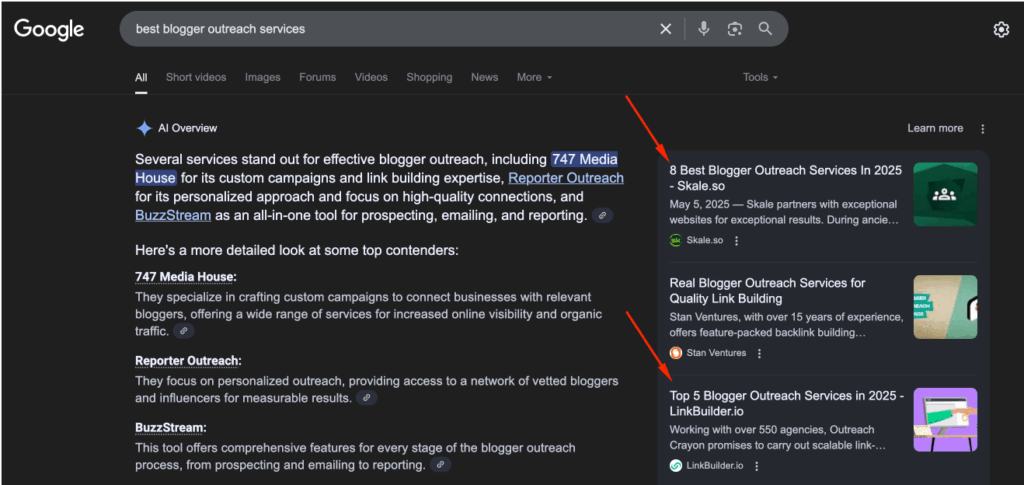
What changes?
Apart from the listicles on your website, you want to be cited in others’.
As many of them as possible!
LLMs look for patterns across multiple sources. More citations across various relevant sites increase the likelihood of getting featured.
Pro tip: Structure your listicles around clear H2/H3 headings and bullet points for easy skimming, and implement schema markup to help LLMs understand your content and increase visibility in rich results.
We invested heavily in listicle link building. Since Q4 2024, we have tried to get included in as many relevant listicle articles as possible. Thanks to this, I started to see certain patterns and their impact on AI search visibility. The more times you are mentioned by others, the greater the chance that AI tools will also mention you.
Our first tactic was going over alternative articles to our tool, but these insertions are not very easy to get since usually it is your competitors who are writing them. Although we managed to convince some of them as well. 🙂
So instead of only focusing on alternative articles, we tried to be included in articles on various relevant categories like marketing reporting tools, social media analytics tools, marketing agency tools, AI tools, etc. (sky is the limit here)
To be honest, there are no best practices for this. The best you can do is to be a very well-established brand, a well-known SEO expert, and have built many very good relationships with different partners (other SEO experts).
This strategy is not easy, it takes time and energy, but it is definitely worth it.
3. Create Comparison Blog Posts
Comparison blog posts are a content marketing staple.
The articles help you establish your product as a better alternative to a competing offering and push users towards their purchase decision.
Semrush is doing in their Ahrefs vs. Semrush blog post published on the Backlinko blog or the Semrush vs. Ahrefs article on Traffic Think Tank (both of which it owns).

These articles attract organic traffic from potential buyers. They also bring mentions and backlinks as other creators reference them in their blog posts, discussions, or reviews.
The Backlinko article has links from 154 domains. The Traffic Think Tank, from 46.


The Backlinko piece also features in the AI Overview for “ahrefs vs semrush,” alongside an article from Exploding Topics, another Semrush brand.

You don’t need to have skin in the game to benefit from writing a product comparison article.
Even if not a Semrush/Ahrefs competitor, writing an honest review objectively comparing their pros and cons will bring traffic and links to your website.
4. Earn Brand Visibility on Reddit and Quora
Reddit has featured prominently in Google SERPs since the core updates in early 2023, and marketers have been exploring ways to leverage it.
The potential of the platforms is incredible, as Nick Malekos has just shown in his LinkedIn post: Most of his posts get 2k+ views after just one month of posting. Such visibility is hard to achieve via other channels.
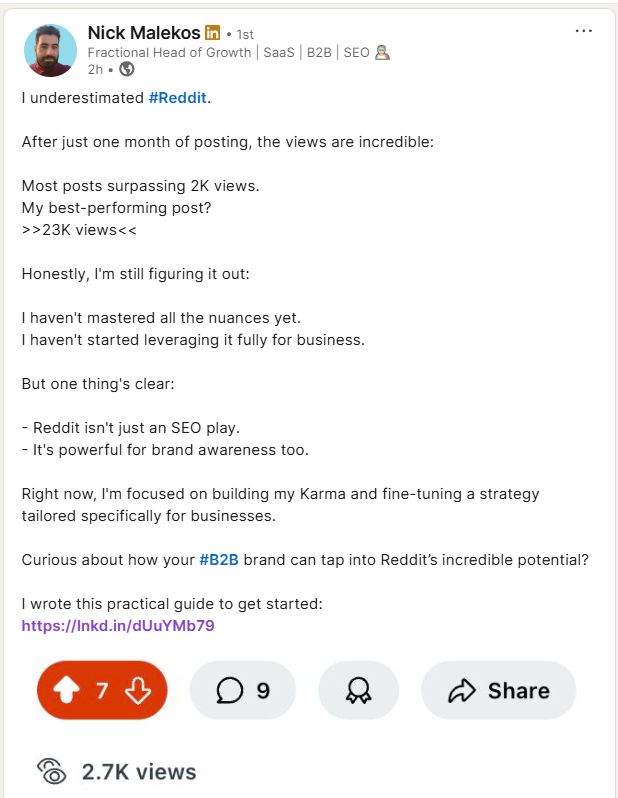
But wait, there’s more!
Their importance will likely increase as LLMs use UGC content in their responses.
Semrush reported last week that Quora and Reddit are already the most cited sources in AI Overviews.

Source: Semrush
Similarly, Ahrefs data for June 2025 shows the two accounted for a substantial mention share.
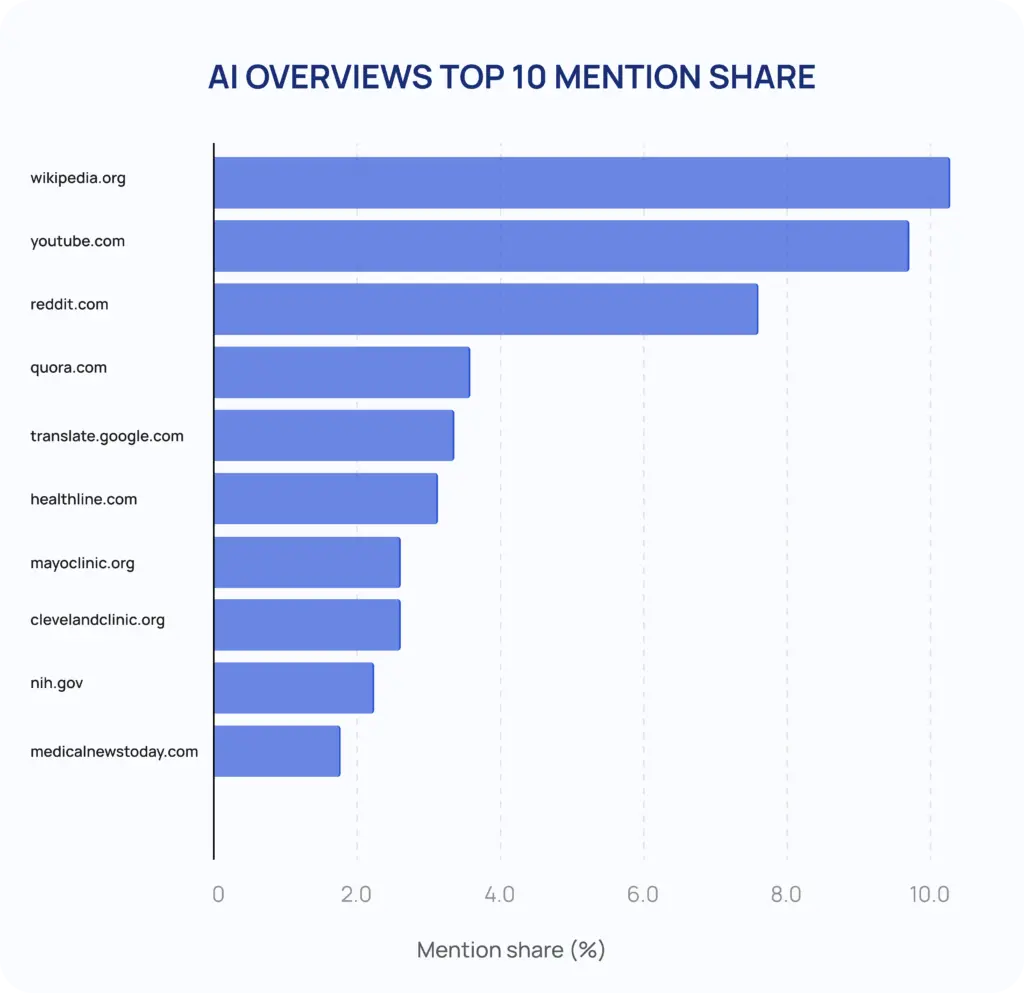
Josh Byskal recently shared study results indicating the trend is also true for ChatGPT.
Reddit isn’t about dropping links, though. Moderators often remove them as spam. It’s about getting your brand mentioned in the right context by participating in high-quality discussions.
Participate intentionally, add value, and avoid spammy promotion.
5. Secure Editorial Backlinks on Trustworthy Pages
Editorial backlinks, or niche edits, are links manually placed within existing content to add value.
They are one of the safest and most reliable link-building strategies.
Placed on relevant pages with existing traffic, visibility, and strong backlink profiles, they “build awareness and strengthen the trust signals that AI systems and search engines rely on,”.
And you don’t have to wait for results for months.
At Editorial.Link we specialize in these kinds of links.
Here are two such links we’ve secured in Databox and Surfer articles.

Get in touch if you want us to get such placements for your business.
6. Create Linkable Assets
Linkable assets are well-researched, in-depth resources that attract backlinks and mentions organically.
Think research reports, case studies, or in-depth guides.
For Maggie Swift, Co-Founder and CEO of Unframed Digital, this is the most effective way to earn links and citations:
The most effective way we’ve earned citations is by creating highly specific, authoritative content that’s deeply useful to niche audiences. Consider unique research, data-supported guides geared for underrepresented sectors, or insightful websites that provide answers to challenging industry queries.
I couldn’t agree more: our last year’s State of Link-Building report got over 254 links from 100+ referring domains (there’s a new one coming out soon!!!).
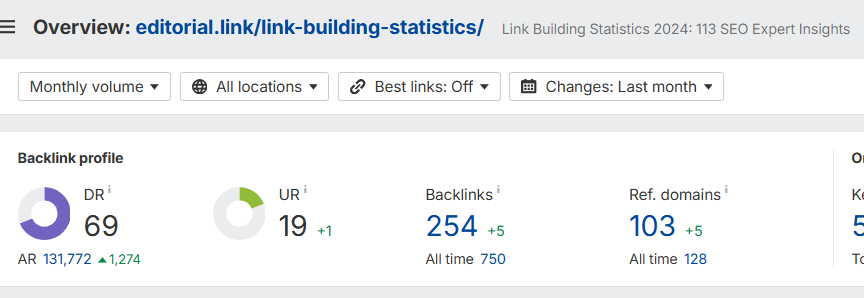
These links give your website an SEO boost.
The content is also used in AI-generated search results.
For example, when I asked how widespread the use of AI in content marketing is, Google AI Overview pulled data from industry reports, including CoSchedule’s State of AI Marketing and an in-depth analysis by Maximize Market Research.
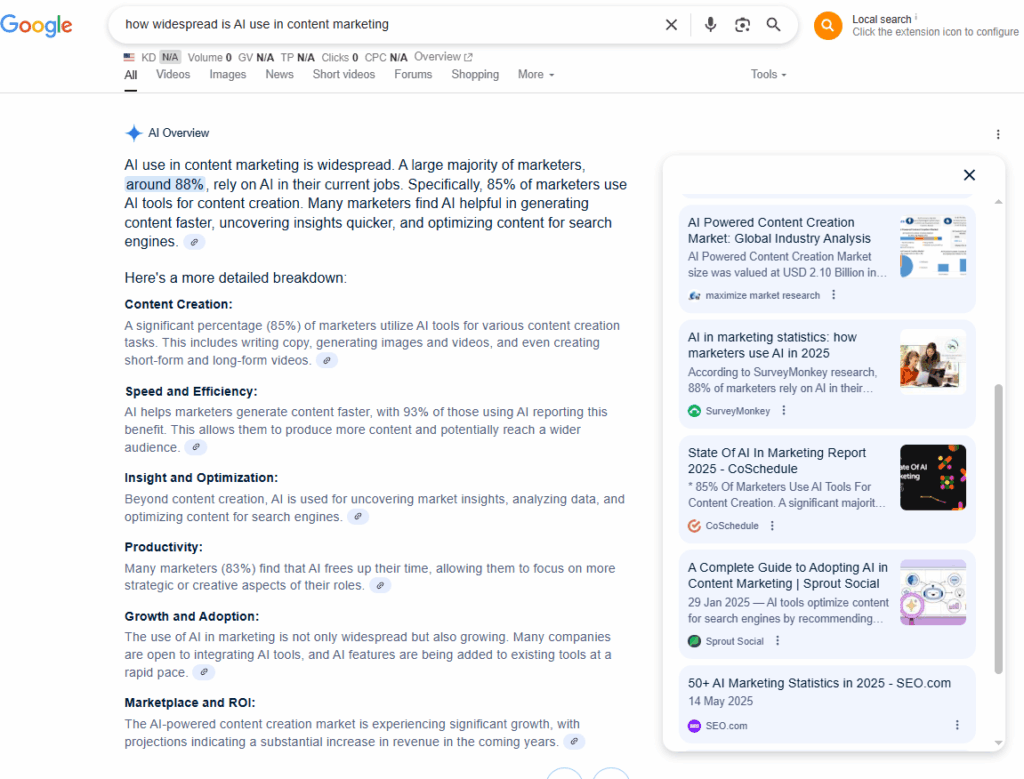
The secret to long-term success?
Creating resources “substantial enough to serve as primary source material… and become reference points for industry discussions”.
That’s why companies invest thousands of $$$ in original research that brings unique data and insights, a trend likely to accelerate.
7. Run Digital PR Campaigns
48,6% of SEO professionals in our recent study named digital PR the most effective link-building tactic in 2025.
Why?
Sharing expert commentary, original research, or timely opinions on trending topics with journalists is a chance to land quality links in major news outlets that are otherwise unattainable.
By producing highly targeted, thoroughly researched articles that tackle industry-specific problems or provide fresh perspectives, we’ve managed to attract attention from well-known outlets. Forming authentic connections with writers and editors has been key, as it ensures our material gets in front of the right audience.
And not just one or two: well-timed campaigns can easily secure up to 10 links.
I believe that digital PR will become even more crucial as we enter the AI-search era.
In traditional search, original insights were enough to rank, at least for strong domains.
However, LLMs don’t look for originality. They look for patterns. To get cited, your ideas need to be featured by multiple reputable sources.
And digital PR is the best way to achieve this.

Source: Ahrefs
8. Respond to Expert Quote Requests
Responding to journalists' requests for expert opinions is another way to secure valuable links and mentions that build your visibility and authority.
How to find them?
Writers for top websites regularly ask their LinkedIn followers for insights and feature them in the articles. Here’s such a request from Mateusz Makosiewicz, who writes for Ahrefs:
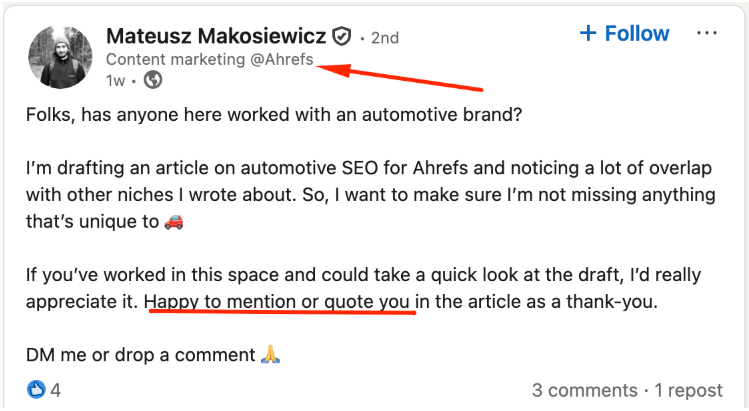
HARO-like services, like Qwoted or Featured, are good alternatives.
The challenge is standing out from the dozens of pitches that writers receive.
For Dennis Shirshikov, the Head of Growth at Growth Limit, the secret sauce is embedding references to data, stats, and case studies:
Hands-down, the best method is by responding to journalist queries through HARO, Qwoted, and Featured with personal details connected to a data point or a case study. We smash that with Statista and unique survey-based data to create citeworthy visual assets that journalists love to reference.
9. Build a Personal Brand
Building a strong personal brand as an expert in your niche aids your SEO efforts.
When your name is consistently linked to high-quality content — for example, through LinkedIn posts or podcast appearances — it strengthens your author entity and builds trust.
And Google rewards content from trustworthy sources.
Over time, this creates a flywheel effect: higher rankings lead to more visibility, which brings more organic mentions, backlinks, and media opportunities.
This also means you’re likely to come up in AI search results as a go-to expert in your niche.
Bots and algos aside, having a strong personality as the front of your business allows you to connect with your target audience on a much more intimate level, Brian Dean noted in his recent conversation with Leigh McKenzie:
"Businesses don't buy from businesses. People who work at businesses buy from other people that work at businesses. The more you can connect with people, the better…"
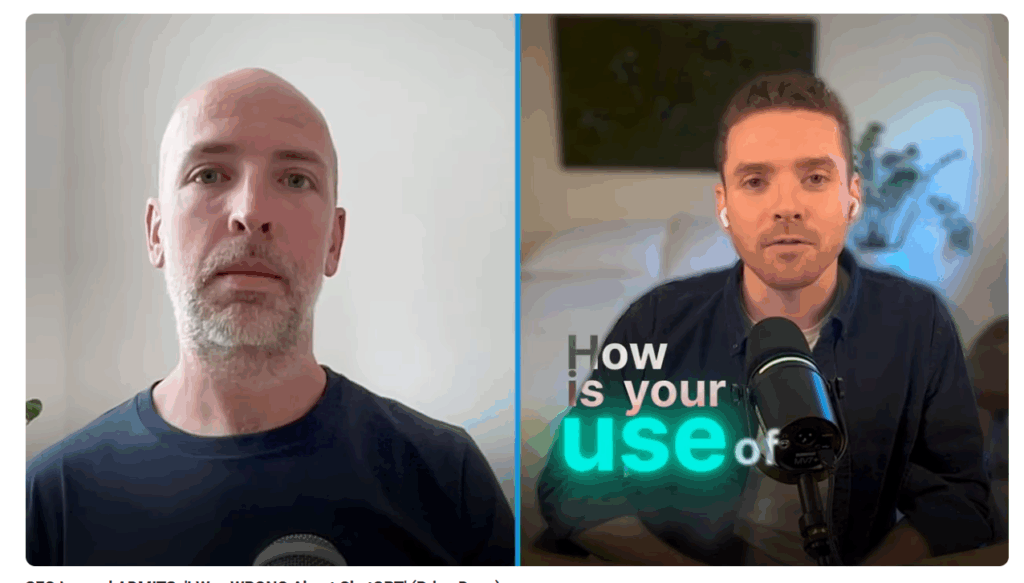
10. Acquire Websites or Businesses in Your Niche
The Backlinko/Traffic Think Tank/Exploding Topics examples illustrate the marketing benefits of acquiring businesses.
By acquiring niche companies, Semrush increased its online visibility in 3 ways:
- Reached new audiences.
- Strengthened their domains’ SEO performance.
- Increased AI search visibility.
These websites cite each other, link to each other, and send referral traffic to each other.
An alternative approach is purchasing similar businesses, integrating their technology into your main tool, and redirecting the original to your domain. Or just their domain, as Neil Patel did with Kissmetrics.
By doing so, you reap the inherent SEO benefits as their link equity passes to your domain.
However, by ‘killing’ the website, you lose a distribution medium, which we have seen matters more for AI search. So this approach will likely become less common.
How to find businesses to acquire?
Use services like Flippa or Empire Flippers. Or ask around your networks.
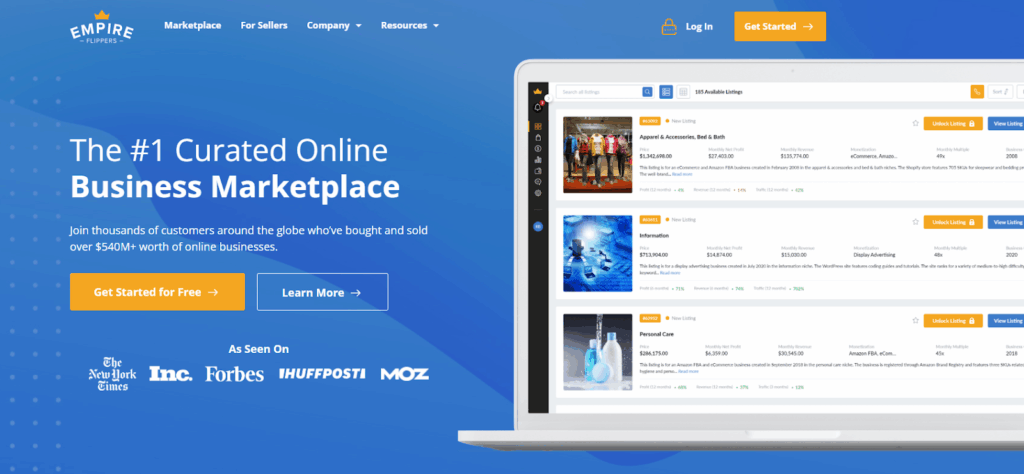
11. Purchase Expired Domains
Purchasing expired domains is a similar tactic to acquiring businesses or domains. Just like them, it allows you to leverage existing SEO capital instead of building it from scratch.
You can find such domains on auction services or marketplaces, like GoDaddy Auctions or SEO.Domains. You can also purchase domains collectively on services such as Shared Domains.
Once purchased, you have two options: rebuild the website and use it for content and link equity distribution, or set up a 301 redirect for SEO benefits only.
The first approach makes more sense these days, as you want your brand or product to be cited across multiple sources.
The challenge? Finding relevant domains with natural link profiles and no spam history.
From my experience, they are rare, and they fetch astronomical prices at auctions.
12. Build Free Tools
According to Neil Patel's data, free tools, like calculators, are the best link magnets, outperforming even original research.
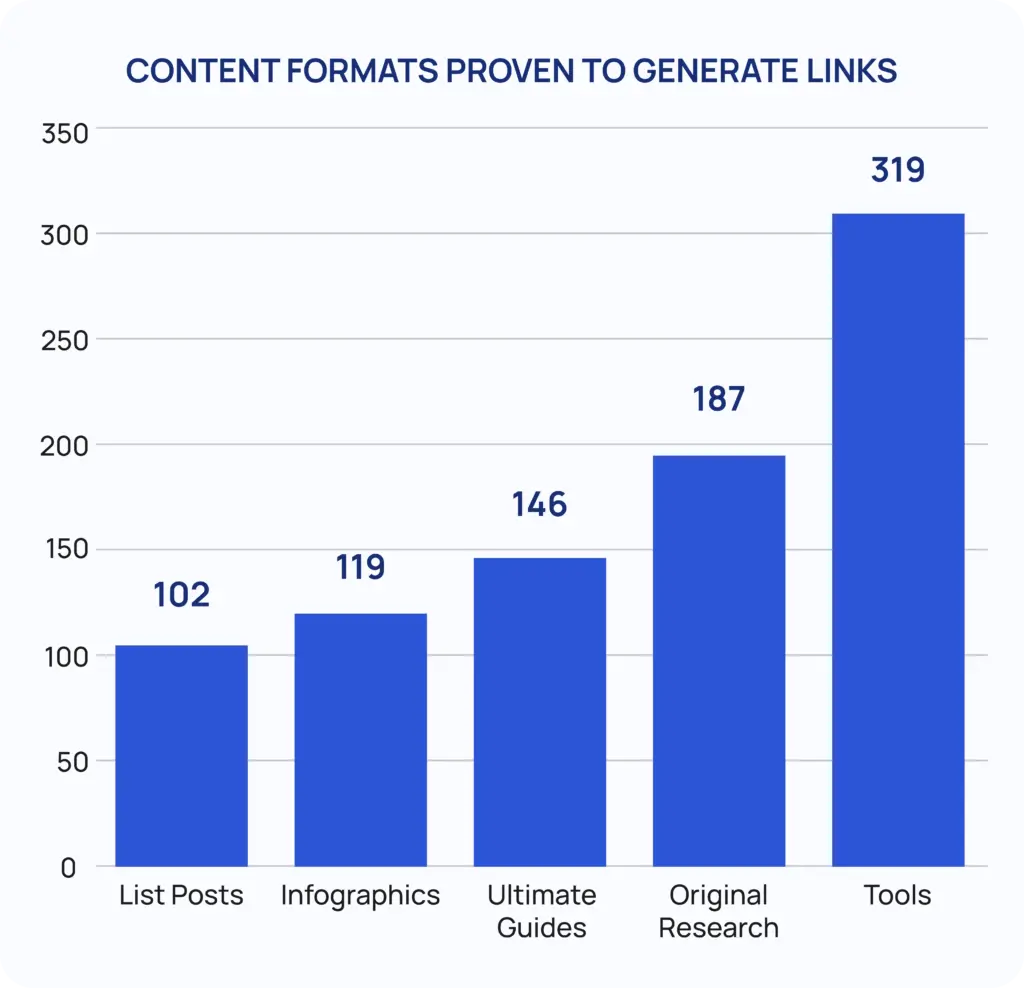
Ahrefs has launched its Brand Radar recently, and it already has 57 unique backlinks.

And their four most linked-to pages, apart from their homepage?
Free tools.
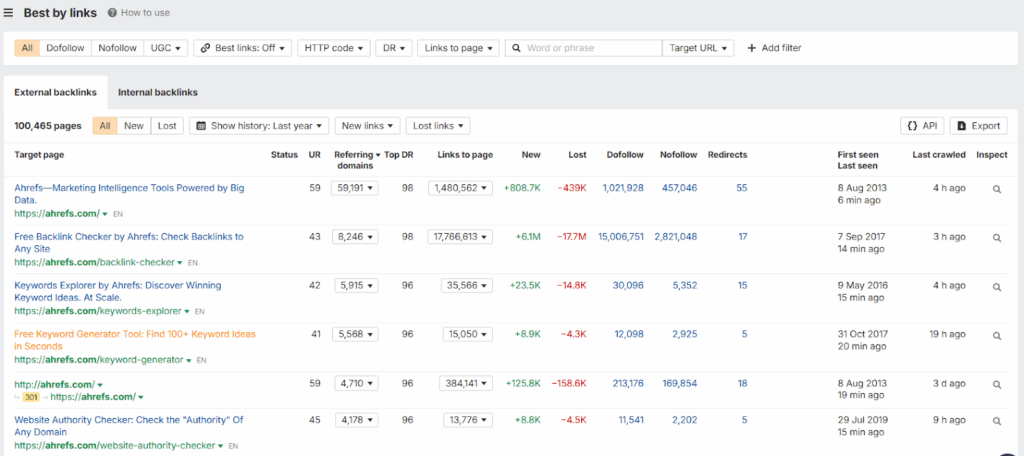
It’s no surprise competitors are joining the race.
Backlinko launched its free SEO Checker two weeks ago, and Leigh McKenzie doesn’t hide that the decision was driven by a competitor.
Apart from earning organic backlinks, Leigh mentions two benefits of free tools:
- They capture high-intent organic traffic: People searching for them need a specific solution.
- They convert users by demonstrating the product value.
They also increase user engagement and time spent on the page, both ranking signals.
This tactic works best for software companies as they can easily make a feature with limited functionality available for free.
No digital product? Try vibe-coding.
13. Guest Post on Reputable Websites
Guest posting is a tried-and-tested strategy involving writing articles for other websites to reach a new audience, increase your visibility, and catch a link or two.
On paper, it sounds good, but frankly, I’m not a big fan of guest posting.
The reason?
High-quality websites don’t accept unsolicited pitches, and if they do, they take ages to respond.
So, getting a good placement can take weeks or months, and landing two quality guest posts a month is tough. So not exactly scalable.
Unless you’re ready to pay for them, which defeats the purpose.
Still, if you put in the time and focus on quality, the tactic can work, as Nikola Baldikov confirms:
Guest posts on trusted industry blogs still work, but only when you’re publishing on sites that actually have authority in your space … think less about sheer volume and more about relevance and trust.
14. Get Featured in Videos and Podcasts
In the “Ahrefs vs Semrush” AI Overview I shared with you above, the first two sources were blog posts.
The next two were YouTube videos, then another blog, and two more videos.
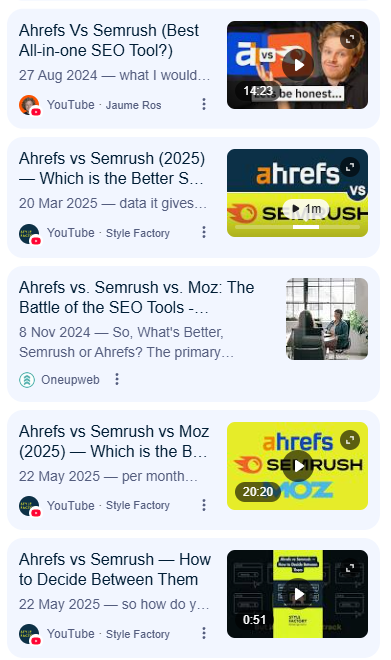
The Semrush, Ahrefs, and Profound data above show that YouTube is a major source for both AI Overviews (~20%) and Perplexity (~15%).
The conclusion? Creating instructional, demonstration, or tool breakdown YouTube videos or appearing in someone else’s is a way to boost your AI visibility.
Videos play a significant role also in organic search SEO:
- Being a guest means backlinks from the hosting channel. Creating videos means links from the guests. And their audiences.
- Embedding multimedia content increases user engagement and keeps them on the page longer, which is a ranking factor, and improves content discoverability.
- Featuring in videos establishes niche authority, leading to more backlinks, mentions, and opportunities.
According to Brian Dean, YouTube is also one of the few not fully saturated channels yet:
"There's just such demand for content on YouTube, especially in specific niche topics that your brand might be perfect to write about. Like if you know how to solder… Your channel can really stand out because there are a lot of people on there who want to see that, and there are probably not a lot of good channels on there."
Breaking through with a podcast is more challenging because of greater saturation. The lower entry barrier means more people are doing it.
However, you can increase your exposure by being a guest on established podcasts:
I believe the most overlooked off-page SEO strategy is participating in industry podcasts and webinars – we’ve seen local businesses boost their domain authority by 15-20 points just by being genuine, helpful guests sharing their expertise.
15. Get Cited in Curated Industry Newsletters
Newsletters are another channel for distributing your ideas and driving online visibility.
For example, Kevin Indig’s Growth Memo, one of the most respected SEO newsletters, has tens of thousands of subscribers, including experts from leading SaaS companies.
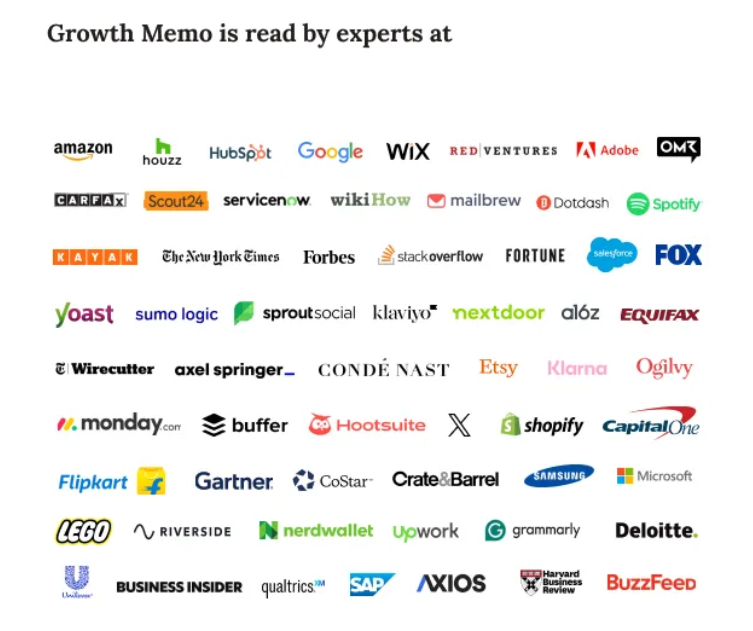
The newsletter is hosted on Kevin’s website. It’s indexable and has a public archive, so it can get picked up in organic search results. And all links pass the link equity if you manage to get one.
Even if they were nofollow or just mentions, they’d still be worth $$$ in exposure.
FAQ: Off-Page SEO Techniques in 2025
Let’s wrap up with a few frequently asked questions.
What is off-page SEO, and why is it important?
Off-page SEO involves all activities outside a website to boost its authority and reputation.
This includes backlink and mention acquisition and content promotion across reputable platforms, social media, and forums.
Off-page SEO benefits your website by:
- Improving search rankings
- Increasing website visibility and traffic, both organic and referral
- Building brand awareness, trust, and reputation
- Boosting user engagement
How has off-page SEO changed with AI Overviews and SGE?
AI Overviews and Search Generative Experience (SGE) have changed off-page SEO significantly.
The main change: the focus is moving beyond backlinks.
Google's AI now emphasizes context, entities, and mentions.
This means your brand's presence on authoritative, relevant pages, even without a direct link, carries real value because these mentions can appear in AI-generated summaries.
What’s the difference between off-page and on-page SEO?
On-page SEO involves optimizations directly within a website’s content and structure.
This includes title tags, meta descriptions, header hierarchy, internal linking, keyword usage, and page-loading performance.
Off-page SEO, or off-site SEO, focuses on activities outside the website to build credibility and authority, including content distribution and promotion to secure backlinks and brand mentions on external platforms.
Both are interdependent: effective off-page isn’t possible without strong on-page foundations.
How do AI Overviews impact off-page SEO strategies today?
AI Overviews have reshaped off-page SEO by prioritizing sources that feed into Google’s AI-generated summaries.
Sites that secure citations within AI Overviews can maintain visibility even when traditional organic listings lose prominence.
Consequently, link-building campaigns now target publications and domains that AI models recognize for reliability and expertise.
At the same time, a lot of the off-page strategies that worked in the pre-AI age are still valid now. For example, Digital PR has always been an effective way to increase visibility in reputable sources, and it isn’t likely to change.
How do I measure off-page SEO effectiveness in 2025?
The off-page metrics, like referring domain count or domain authority, remain valid tools for measuring SEO effectiveness in 2025.
However, as LLMs don’t rely exclusively on backlinks but also on unlinked mentions, there’s a need to supplement them with others.
For example, platforms like Brand24 or Mention allow you to track web mentions, social media signals, and user sentiment, all of which can affect your visibility in AI search responses.
More solutions for monitoring LLM visibility, like Ahrefs Brand Radar or Semrush AI Toolkit, are expected.
Final Words
AI is transforming how people search for information. Getting featured in AI search results requires an even better content distribution because LLMs surface ideas that are widely cited.
Fortunately, many off-page SEO strategies you have used remain effective and help you achieve AI search visibility.
For example, high-quality backlinks from trusted sources still play an important role.
Do you need help with building them? Get in touch with Editorial.Link.









